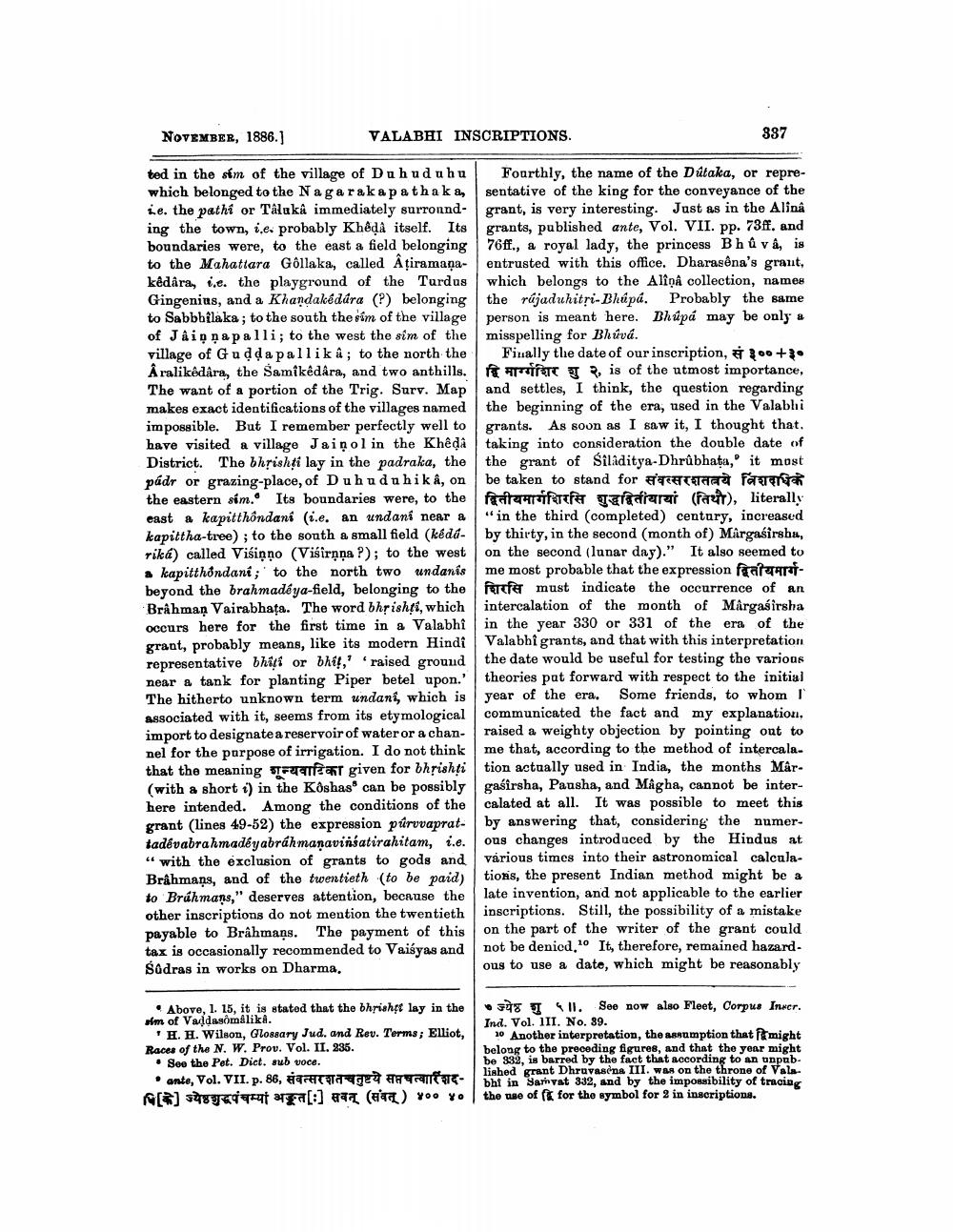________________
NOVEMBER, 1886.)
VALABHI INSCRIPTIONS.
887
ted in the sem of the village of Duhuduhu Fourthly, the name of the Dátaka, or reprewhich belonged to the Nagarakap athaka, sentative of the king for the conveyance of the ie. the pathi or Talukâ immediately surronnd- grant, is very interesting. Just as in the Alina ing the town, i.e. probably Khed itself. Its grants, published ante, Vol. VII. pp. 73ff. and boundaries were, to the east a field belonging | 76ff., a royal lady, the princess Bhava, is to the Mahattara Gôllaka, called Atiramana- entrusted with this office. Dharasena's grant, kêdâra, i.e. the playground of the Turdus which belongs to the Alînê collection, names Gingenius, and a Khandakédára (?) belonging the rújaduhitri-Bhópá. Probably the same to Sabbbilaka; to the south the sím of the village person is meant here. Bhúpá may be only a of Jain napalli; to the west the sim of the misspelling for Bhúvá. village of Gudda pallika; to the north the Finally the date of our inscription, + Åralikêdára, the Samîkêdara, and two anthills. Arrift , is of the utmost importance, The want of a portion of the Trig. Surv. Map and settles, I think, the question regarding makes exact identifications of the villages named the beginning of the era, used in the Valabhi impossible. But I remember perfectly well to grants. As soon as I saw it, I thought that. have visited a village Jaiņol in the Khêda taking into consideration the double date of District. The bhrishti lay in the padraka, the the grant of Siladitya-Dhrûbhata," it most pádr or grazing-place, of Duhu du hikâ, on be taken to stand for errad farer the eastern sim.. Its boundaries were, to the faithrifti Tariciari (fazi), literally east a kapitthôndani (i.e. an undani near a "in the third (completed) century, increased kapittha-tree) ; to the south a small field (kéda- by thirty, in the second month of) Margasirsba, rika) called Visiņņo (Visirņņa ?); to the west on the second (lunar day)." It also seemed to
kapitthondani ;' to the north two undanis | me most probable that the expression द्वितीयमार्गbeyond the brahmadé ya-field, belonging to the force must indicate the occurrence of an Brahman Vairabhata. The word bhrishti, which intercalation of the month of Margasirsha occurs here for the first time in a Valabhi in the year 330 or 331 of the era of the grant, probably means, like its modern Hindi Valabhi grants, and that with this interpretation representative bhalf or bhit,' raised ground the date would be useful for testing the various near a tank for planting Piper betel upon.' theories pat forward with respect to the initial The hitherto unknown term undani, which is year of the era. Some friends, to whom 1 associated with it, seems from its etymological communicated the fact and my explanation, import to designate a reservoir of water or a chan- raised a weighty objection by pointing out to nel for the purpose of irrigation. I do not think me that, according to the method of intercalathat the meaning Traian given for bhsishți tion actually used in India, the months Már(with a short t) in the Köshas can be possibly gaśirsha, Pausha, and Mågha, cannot be interhere intended. Among the conditions of the calated at all. It was possible to meet this grant (lines 49-52) the expression púrvvaprat- by answering that, considering the numertadávabrahmadéyabráhmanaviñsatirahitam, i.e. ous changes introduced by the Hindus at " with the exclusion of grants to gods and various times into their astronomical calculaBrahmans, and of the twentieth (to be paid) tions, the present Indian method might be a to Bráhmans," deserves attention, because the
late invention, and not applicable to the earlier other inscriptions do not mention the twentieth inscriptions. Still, the possibility of a mistake payable to Brahmaņs. The payment of this on the part of the writer of the grant could tax is occasionally recommended to Vaiấyas and not be denied. It, therefore, remained hazard. Sadras in works on Dharma.
ous to use a date, which might be reasonably
• Above, 1. 15, it is stated that the bhrishçe lay in the 308 I II. See now also Fleet, Corpus Inscr. alm of Valdas malika.
Ind. Vol. III. No. 89. "H. H. Wilson, Glossary Jud. and Rev. Terms; Elliot,
10 Another interpretation, the assumption that it might Races of the N. W. Prov. Vol. II. 235.
belong to the preceding figures, and that the year might • See the Pet. Dict. sub voce.
be 932, is barred by the fact that according to an unpub.
lished grant Dhruvas na III. Was on the throne of Vals ante, Vol. VII. p. 86, arta
T-|
bht in Sarhvat 332, and by the impossibility of tracing A ) s y y at ara[:] . (TL) Yo Yo the use of for the symbol for 2 in insoriptions.




